6th Grade operations with integers: Adding, Subtracting, Multiplying, and Dividing
Welcome to the exciting world of 6th-grade operations with integers! In this crucial stage of your 6th grader’s mathematical journey, please allow them to delve into the fascinating realm of adding, subtracting, multiplying, and dividing integers.
-
6th Grade Math Skills: How to perform operations with integers correctly and confidently
For parents and teachers looking for new ways to uplift their 6th grader’s 5th-grade math skills, this is the right place. In this article, you will find an excellent collection of Mathskills4kids’ 6th Grade operations with integers worksheets and tips on performing operations with integers correctly and confidently.
This article aims to unlock the secrets of numbers with positive and negative values and discover how these operations can be applied to real-life situations.
However, whether navigating deep-sea treasure hunts or calculating the temperature on a chilly winter day, mastering operations with integers is essential for building a solid mathematical foundation.
Throughout this engaging and interactive guide, we will break down complex concepts into bite-sized pieces, providing clear explanations and practical examples for students to conquer any integer equation that comes their way.
So, help your children to buckle up and prepare for an adventure through the world of integers, where they’ll develop invaluable problem-solving skills that will benefit them throughout their academic journey and beyond.
-
BROWSE THE WEBSITE
-
DOWNLOAD FREE WORKSHEETS
-
-
GRADE 6 MATH TOPICS
- Whole numbers
- Multiplication
- Division
- Exponents and square roots
- Number theory
- Decimals
- Add & subtract decimals
- Multiply & divide decimals
- Fractions & mixed numbers
- Add & subtract fractions
- Multiply fractions
- Divide fractions
- Integers
- Operations with integers
- Mixed operations
- Rational numbers
- Problems solving
- Ratio & proportions
- Percentages
- Measuring units
- Money math
- Consumer math
- Telling time
- Coordinate graph
- Algebraic expressions
- One step equations
- Solve & graph inequalities
- Two-step equations
- 2D Geometry
- Symmetry & transformation
- 3D Shapes
- Geometry measurement
- Data and Graphs
- Statistics
- Probability
-
-
How to add integers with different signs
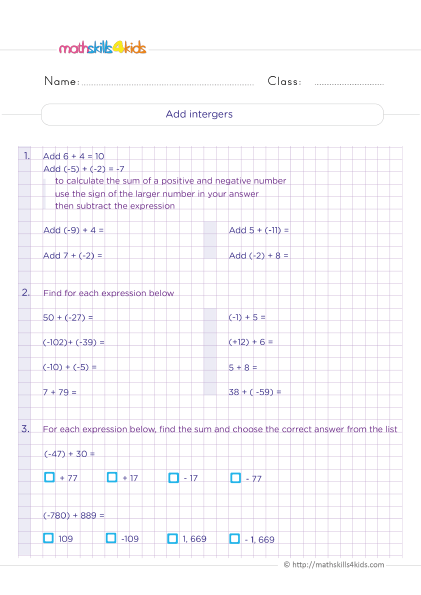 Print it...
Print it...
-
Understand the rule for subtracting integers
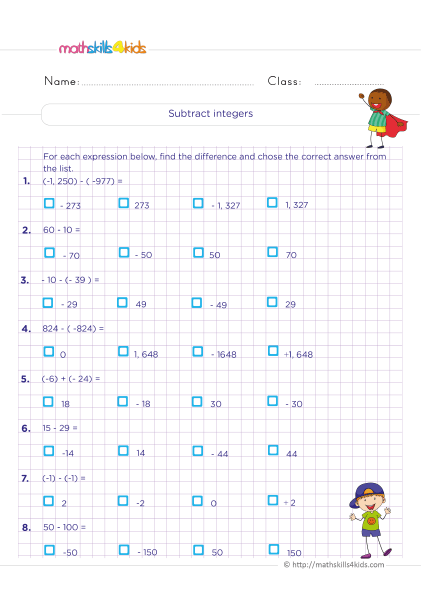 Print it...
Print it...
-
Add & subtract integers: Find the sign
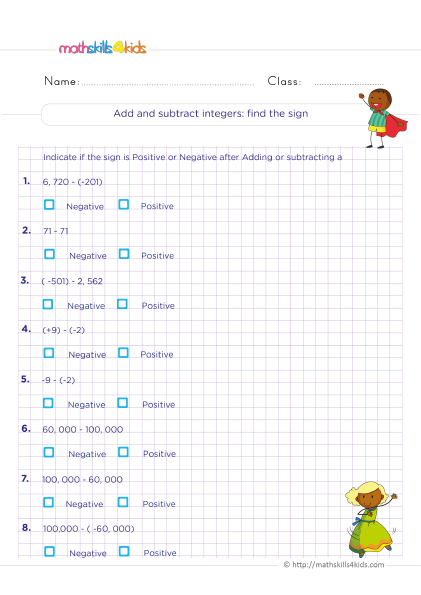 Print it...
Print it...
-
Adding three or more integers
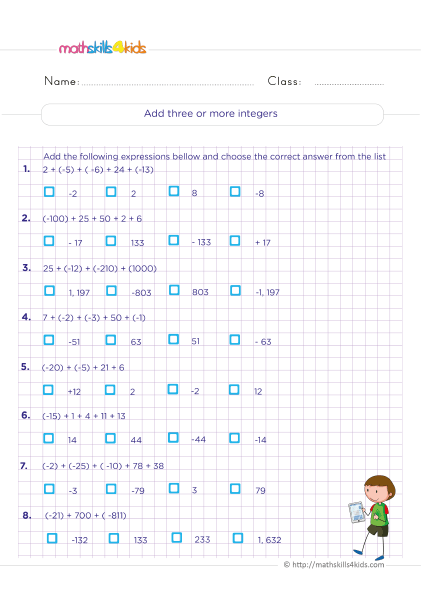 Print it...
Print it...
-
How to do multiplication of integers with different signs
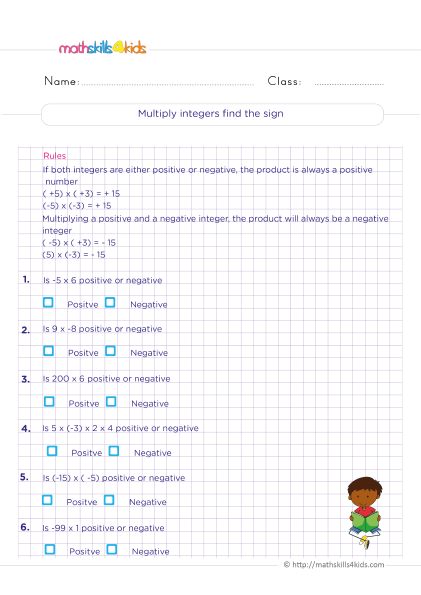 Print it...
Print it...
-
Dividing integers practice - How to divide negative and positive integers
 Print it...
Print it...
-
How to add integers with different signs
-
Buying is supporting us!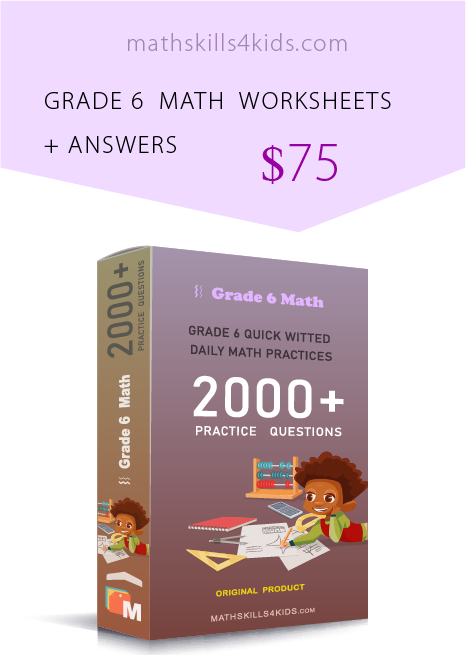
Buy Now...
-
-
What are integers, and why are they important?
Do you know what integers are? Do you also know why they are important? Let’s find out together!
Integers are numbers that do not have fractions or decimals. They can be written as ... (1) or ... (-1). The symbol ℤ denotes the set of integers, and it includes all the positive and negative whole numbers and zero. For example, 5, -3, 0, 12, and -8 are all integers.
Integers are useful for representing situations that involve changes or differences. For example, if the temperature rises by 5 degrees Celsius, we can write this as +5. If the temperature drops by 3 degrees Celsius, we can write this as -3. If the temperature stays the same, we can write this as 0. Similarly, if we gain $10, we can write this as +10. If we lose $7, we can write this as -7. If we have no change in money, we can write this as 0.
-
What are children supposed to learn about integers in Grade 6?
In Grade 6, children are expected to learn to add, subtract, multiply, and divide integers using various methods and tools. They should also be able to apply the order of operations with integers and solve word problems involving operations with integers. Some of the specific skills that children should master by the end of Grade 6 are:
- Identify and compare integers using a number line
- Use a number line to model addition and subtraction of integers
- Use rules of signs to multiply and divide integers
- Use parentheses and brackets to group expressions with integers
- Apply the order of operations (PEMDAS) with integers
- Solve word problems involving operations with integers
- Use integers worksheets for practice and assessment
-
How to add and subtract integers using a number line
A number line is a horizontal line with numbers marked at equal intervals. It can help us visualize and perform addition and subtraction of integers. To add or subtract integers using a number line, we follow these steps:
- Locate the first integer on the number line
- Move to the right if the second integer is positive or to the left if the second integer is negative
- The distance and direction of the movement is determined by the absolute value of the second integer
- The final position on the number line is the sum or difference of the two integers
For example:
- To add 4 + (-2), we start at 4 on the number line and move 2 units to the left because -2 is negative. The final position is 2, which is the sum of 4 and -2.

- To subtract 4 - (-2), we start at 4 on the number line and move 2 units to the right because -(-2) is positive. The final position is 6, which is the difference of 4 and -2.

-
How to multiply and divide integers using rules of signs
To multiply or divide integers, we do not need a number line. We can use rules of signs to determine the sign of the product or quotient. The rules of signs are:
- The product or quotient of two positive integers is positive
- The product or quotient of two negative integers is positive
- The product or quotient of a positive integer and a negative integer is negative
- The product or quotient of zero and any integer is zero
For example:
- To multiply 4 x (-3), we use the rule that the product of a positive integer and a negative integer is negative. Therefore, 4 x (-3) = -12.
- To divide -12 / (-3), we use the rule that the quotient of two negative integers is positive. Therefore, -12 / (-3) = 4.
-
Summary table for operations with integers rules
ADDITION
SUBTRACTION
MULTIPLICATION
DIVISION
+ and + = +
+ and + = +
+ and + = +
─ and ─ = +
─ and ─ = ─
─ and ─ = ─
─ and ─ = +
+ and + = +
+ and ─ = use the sign of bigger number
+ and ─ = +
+ and ─ = ─
+ and ─ = ─
─ and + = use the sign of bigger number
─ and + = ─
─ and + = ─
─ and + = ─
-
How to apply the order of operations with integers
The order of operations is a set of rules that tells us which operation to perform first when there is more than one operation in an expression. The order of operations is:
- Parentheses (or brackets)
- Exponents (or powers)
- Multiplication and Division (from left to right)
- Addition and Subtraction (from left to right)
The acronym PEMDAS can help us remember the order of operations.
For example, to simplify the expression 2 + (3 x -4) - (-5) / 5, we follow these steps:
- Simplify the parentheses first: 2 + (-12) - (-5) / 5
- Simplify the division next: 2 + (-12) - (-1)
- Simplify the addition and subtraction from left to right: -10 - (-1) = -9
-
Word problems involving operations with integers
Word problems are problems that use words to describe a situation that involves mathematics. To solve word problems involving operations with integers, we follow these steps:
- Read the problem carefully and identify the question
- Identify the given information and the unknowns
- Choose a variable to represent the unknowns
- Write an equation or expression that models the situation using the given information and the variable
- Solve the equation or expression using the appropriate operations and methods
- Check the solution by plugging it back into the equation or expression
- Write the answer in a complete sentence
For example, solve this word problem:
A submarine is at a depth of -200 meters below sea level. It ascends 50 meters and then descends 75 meters. What is its final depth?
- The question is: What is its final depth?
- The given information is: The submarine is at a depth of -200 meters below sea level. It ascends 50 meters and then descends 75 meters.
- The unknown is: The final depth of the submarine
- Let x be the variable that represents the final depth of the submarine
- Write an equation that models the situation: x = -200 + 50 - 75
- Solve the equation using addition and subtraction: x = -225
- Check the solution by plugging it back into the equation: -225 = -200 + 50 - 75
- Write the answer in a complete sentence: The final depth of the submarine is -225 meters below sea level.
Bonus: online resources for practicing operations with integers in Grade 6
Besides Mathskills4kids’ integers worksheets, other online resources can help children practice operations with integers in Grade 6. These resources include games, videos, quizzes, and interactive activities. Here are some examples of online resources for practicing 6th Grade operations with integers activities:
- Khan Academy: This website has video lessons and interactive exercises on various topics, including operations with integers. Students can choose their grade level and skill level and track their progress. [https://www.khanacademy.org/math/arithmetic/arith-review-negative-numbers](https://www.khanacademy.org/math/arithmetic/arith-review-negative-numbers)
- Math Games: This website has fun and engaging games that help learners practice operations with integers. They can play against the computer or with other players and earn points and badges. [https://www.mathgames.com/skill/6.1-add-and-subtract-integers](https://www.mathgames.com/skill/6.1-add-and-subtract-integers)
- Math Goodies: This website has lessons, worksheets, and quizzes on operations with integers. Students can also download a free ebook on integers that covers all the topics in this article. [https://www.mathgoodies.com/lessons/vol5/intro](https://www.mathgoodies.com/lessons/vol7/operations_integers)
-
-
Thank you for sharing the links of MathSkills4Kids.com with your loved ones. Your choice is greatly appreciated.
Conclusion
To conclude, we must never forget that operations with integers are useful for math and many real-world situations. For example, we can use them to:
- Measure temperature changes (positive or negative)
- Calculate profits or losses (positive or negative)
- Compare altitudes (above or below sea level)
- Represent directions (north or south, east or west)
- Keep track of scores in games (positive or negative)
So, operations with integers are essential for understanding and solving many problems in life.
We hope you enjoyed this article and learned something new.
Happy learning!
